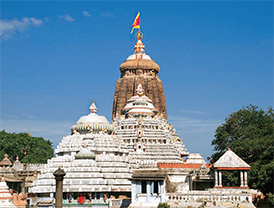
Odisha is a perfect getaway for the religious-minded, architecture lovers, connoisseurs of dance forms, shutter-bugs and nature lovers.
The three links of Odisha’s Golden Triangle are the 12th Century Jagannath temple in Puri, Bhubaneshwar (Odisha’s capital city) and the Konark Sun Temple.
The Jagannath temple
The temple, which is about 3 km from Puri bus-stop and railway station, is a part of the Char Dham (four divine sites) pilgrimage that Hindus are expected to make in their lifetime. The four sites are Badrinath Temple (Uttarakhand) in the North, Puri’s Jagannath Temple in the East, Dwarkadheesh temple (Dwarka in Gujarat) in the West and Ramnathaswamy temple (Rameshwaram in Tamil Nadu) in the South. The history of Jagannath dates back to the Rig Veda, Puranas, Ramayana and it is even believed that the Pandavas of Mahabharata came here to worship lord Jagannath.
Structure: The intricately carved Jagannath temple, built as per the Kalinga style of architecture, towers 214 feet from the ground level and is one of the tallest monuments in Odisha. The temple is enclosed by an inner and an outer compound wall. The four gates for entry are the Eastern Singhadwara (Lion Gate), southern Ashwadwara (Horse Gate), western Vaghadwara (Tiger Gate) and northern Hastidwara (Elephant Gate). On entry through the Lion gate, there is a flight of 22 steps to reach the inner compound wall. While ascending the steps, on the left there is a massive kitchen since daily offerings (bhoga) are made to the Lord six times a day. In an achievement of sorts, it is said that the Puri temple can feed one lakh persons in just a few hours.
The main statues: Apart from the three main idols of Jagannath, Balabhadra and Subhadra, Sudarshan is the fourth important divine manifestation. It is believed by some that Jagannath is Vishnu, Balabhadra is Shiva and Subhadra is Durga indicating the equal importance of Vaishnavism, Shaivism and Shaktism here.
Incomplete structures: As per belief, Lord Vishnu told King Indradyumna that he would make the temple idols on the condition that he would be undisturbed. But since there was no sound from the temple, concerned Queen Gundicha had the door opened but there was no sign of the carpenter and the incomplete idol was devoid of hands, which has been maintained till date.
Rath yatra: The temple is famous for its annual Rath Yatra (chariot festival) sometime in June-July in which the three deities are taken in a procession and travel about 3 km through the main street of Puri up to the Gundicha temple. The approximately 45 feet high and 35 feet wide chariots are pulled by devotees. Then there is the ‘Chhera Pahara’ ritual where the Raja of Puri sweeps the path of the chariot and then people, irrespective of caste, creed, religion and sex, pull the chariots signifying that for God, all are equal.

